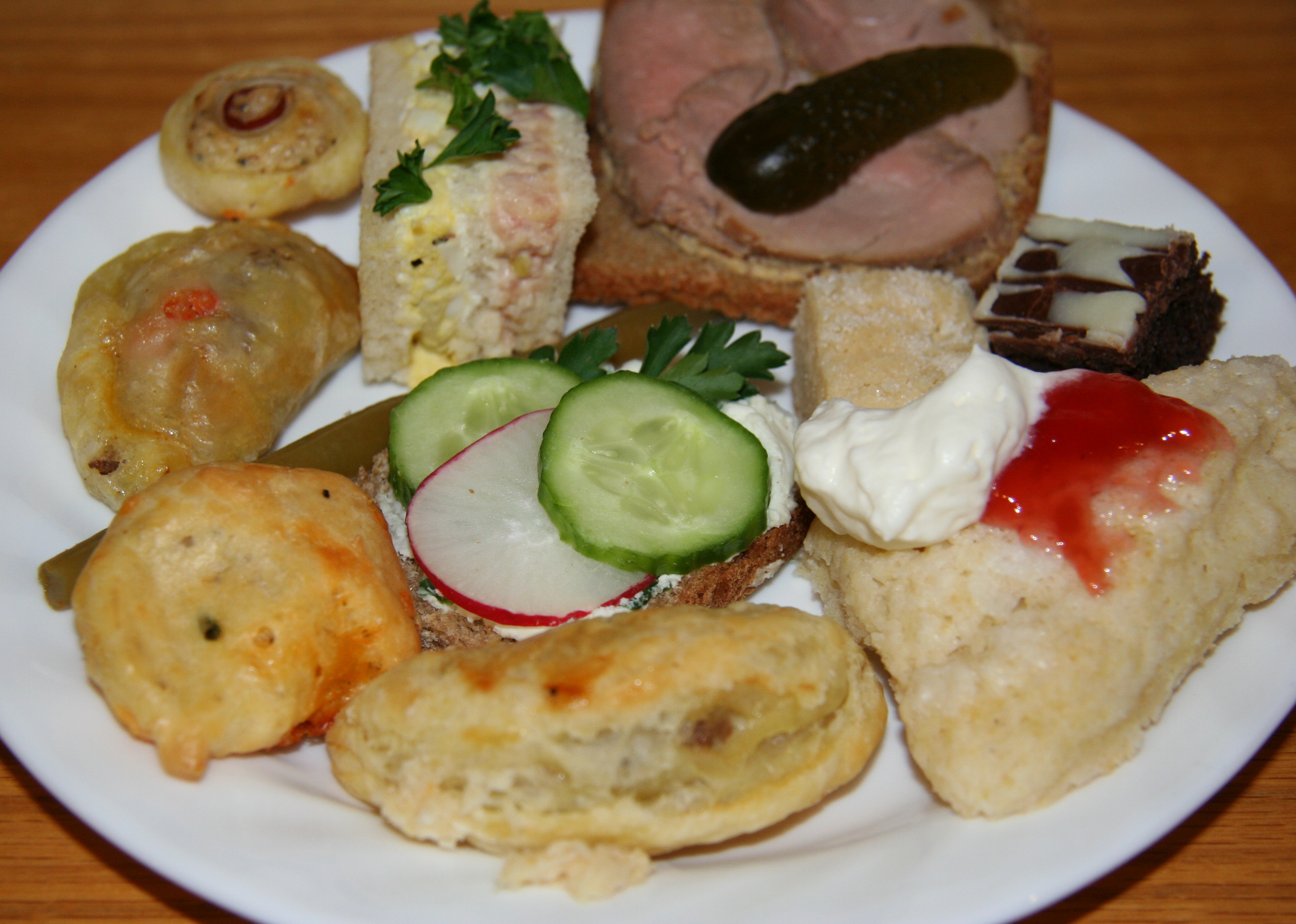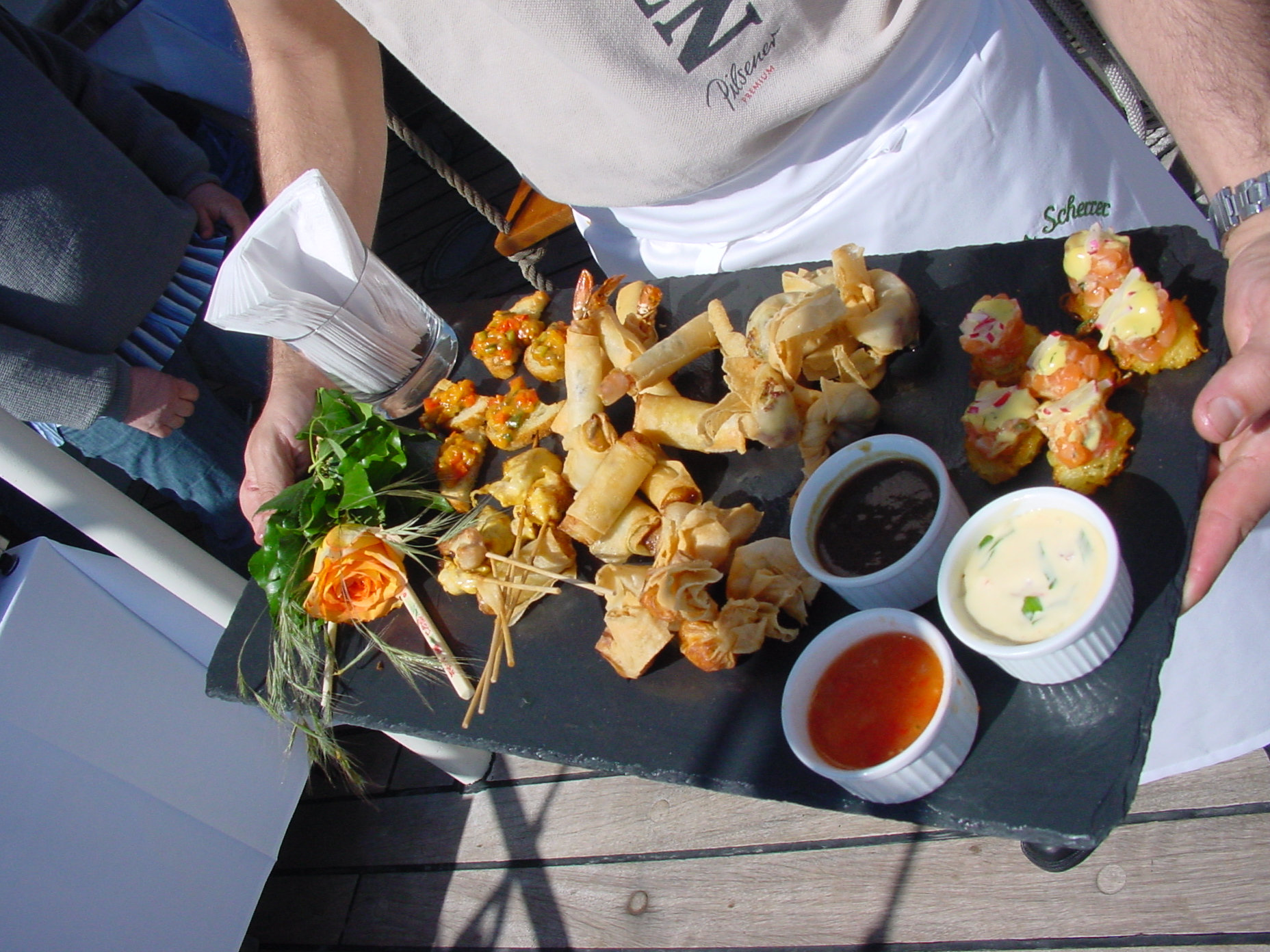Finger Food on:
[Wikipedia]
[Google]
[Amazon]

 Finger foods are small, individual portions of
Finger foods are small, individual portions of
 Drinks before dinner became a custom towards the end of the 19th century. As this new fashion caught on, the British took inspiration from the French to begin serving hors d'oeuvres before dinner. A cocktail party is considered a small gathering with mixed drinks and light snacks. Hors d'oeuvres may be served as the only food offering at cocktail parties and receptions, where no dinner is served afterward. After the end of
Drinks before dinner became a custom towards the end of the 19th century. As this new fashion caught on, the British took inspiration from the French to begin serving hors d'oeuvres before dinner. A cocktail party is considered a small gathering with mixed drinks and light snacks. Hors d'oeuvres may be served as the only food offering at cocktail parties and receptions, where no dinner is served afterward. After the end of
 Most
Most
 Finger foods are small, individual portions of
Finger foods are small, individual portions of food
Food is any substance consumed by an organism for nutritional support. Food is usually of plant, animal, or fungal origin, and contains essential nutrients, such as carbohydrates, fats, proteins, vitamins, or minerals. The substance is inge ...
that are eaten out of hand. They are often served at social events. The ideal finger food usually does not create any mess (i.e. no crumbs, drips, or any kind of mess), but this criterion is often overlooked in order to include foods like tacos
A taco (, , ) is a traditional Mexican food consisting of a small hand-sized corn- or wheat-based tortilla topped with a filling. The tortilla is then folded around the filling and eaten by hand. A taco can be made with a variety of fillin ...
. One origin for finger foods is the French canapé
A canapé () is a type of hors d'oeuvre, a small, prepared, and often decorative food, consisting of a small piece of bread (sometimes toasted) wrapped or topped with some savoury food, held in the fingers and often eaten in one bite.
Name
T ...
.
History of finger foods
Finger foods do not share common origin, history, or identity. Most of them originate in hors d'oeuvre likecanapé
A canapé () is a type of hors d'oeuvre, a small, prepared, and often decorative food, consisting of a small piece of bread (sometimes toasted) wrapped or topped with some savoury food, held in the fingers and often eaten in one bite.
Name
T ...
. During the Middle Ages
In the history of Europe, the Middle Ages or medieval period lasted approximately from the late 5th to the late 15th centuries, similar to the post-classical period of global history. It began with the fall of the Western Roman Empire a ...
formal French meals were served with entremets between the serving of plates. These secondary dishes could be either actual food dishes, or elaborate displays and even dramatic or musical presentations. In the 14th century, recipes for entremets were mostly made with meat, fish, pork and vegetables. By the 15th century the elaborate display and performances were served up between courses, and could be edible or displays of subjects relevant to the host, created in butter sculpture
Butter sculptures are three-dimensional works of art created with butter, a dairy product made from the fat and protein components of churned cream. The works often depict animals, people, buildings and other objects. They are best known as attra ...
or other types of crafted work. With the introduction in the 17th century of ''service à la française
(; "service in the French style") is the practice of serving various dishes of meal at the same time, with the diners helping themselves from the serving dishes. That contrasts to (; "service in the Russian style") in which dishes are brought ...
'', where all the dishes are laid out at once in very rigid symmetrical
Symmetry (from grc, συμμετρία "agreement in dimensions, due proportion, arrangement") in everyday language refers to a sense of harmonious and beautiful proportion and balance. In mathematics, "symmetry" has a more precise definiti ...
fashion, entremets began to change in meaning but were still mainly savoury. Along with this came elaborate silver and ceramic table displays as well as pièces montées. The entremets were placed between the other dishes within the main work of the meal. One kind of finger food is the French canapé, known since the late 1700s. Canapés began as slices of toasted or fried bread with various toppings. Their name, literally 'sofa', was inspired from how the toppings "sat" on the bread as though it were a sofa. Over time, canapés became a word to describe all finger foods served at parties.
 Drinks before dinner became a custom towards the end of the 19th century. As this new fashion caught on, the British took inspiration from the French to begin serving hors d'oeuvres before dinner. A cocktail party is considered a small gathering with mixed drinks and light snacks. Hors d'oeuvres may be served as the only food offering at cocktail parties and receptions, where no dinner is served afterward. After the end of
Drinks before dinner became a custom towards the end of the 19th century. As this new fashion caught on, the British took inspiration from the French to begin serving hors d'oeuvres before dinner. A cocktail party is considered a small gathering with mixed drinks and light snacks. Hors d'oeuvres may be served as the only food offering at cocktail parties and receptions, where no dinner is served afterward. After the end of prohibition
Prohibition is the act or practice of forbidding something by law; more particularly the term refers to the banning of the manufacture, storage (whether in barrels or in bottles), transportation, sale, possession, and consumption of alcoholic ...
in the United States, the cocktail party gained acceptance. Prior to the First World War, American dinner guests would be expected to enter the dining room immediately where drinks would be served at the table with appetisers. This changed by the 1920s, when hors d'oeuvres were served prior to a non-alcoholic
An alcohol-free or non-alcoholic drink, also known as a temperance drink, is a version of an alcoholic drink made without alcohol, or with the alcohol removed or reduced to almost zero. These may take the form of a non-alcoholic mixed drink (a "v ...
cocktail; however, after the repeal of Prohibition in the United States
The repeal of Prohibition in the United States was accomplished with the passage of the Twenty-first Amendment to the United States Constitution on December 5, 1933.
Background
In 1919, the requisite number of state legislatures ratified the Eig ...
, cocktail parties became popular with many different hors d'oeuvres meant as something to help counter the stronger drinks. It is the cocktail party that helped transfer the hors d'oeuvres from the formal dining table to the mobility of the serving tray. These appetisers passed around the cocktail party may also be referred to as canapés.
Finger foods and prohibition
Canapés were often served in speakeasies during American Prohibition. Following the enactment of American Prohibition laws in 1920, many people drank in secret, often inspeakeasies
A speakeasy, also called a blind pig or blind tiger, is an illicit establishment that sells alcoholic beverages, or a retro style bar that replicates aspects of historical speakeasies.
Speakeasy bars came into prominence in the United States ...
. To ensure that guests did not appear intoxicated after leaving to avoid detection, speakeasies often served finger foods throughout the night. These finger foods also allowed guests to eat while drinking because of the food's small size.
After Prohibition, canapés were often served at cocktail parties
A cocktail party is a party at which cocktails are served. It is sometimes called a cocktail reception. A cocktail party organized for purposes of social or business networking is called a mixer.
A cocktail hour is sometimes used by manag ...
.
Modern finger foods
There is a wide variety of finger foods. Contemporary finger foods are often served asfast food
Fast food is a type of mass-produced food designed for commercial resale, with a strong priority placed on speed of service. It is a commercial term, limited to food sold in a restaurant or store with frozen, preheated or precooked ingredien ...
as well as at formal events.
Fast food
 Most
Most fast food
Fast food is a type of mass-produced food designed for commercial resale, with a strong priority placed on speed of service. It is a commercial term, limited to food sold in a restaurant or store with frozen, preheated or precooked ingredien ...
is finger food. Finger food is quick to eat, and can be eaten on the go. For producers, the simple recipes of finger foods allows them to create new menu options that share ingredients.
Parties and events
Finger foods are often served at formal events and celebrations in the form of passed hors d'oeuvre, where they create a casual, relaxed atmosphere and keep guests' hands and fingers entertained.References
Further reading
* ''The McDonaldization of Society'' (SAGE Publications, Inc.), George Ritzer {{DEFAULTSORT:Finger Food Eating behaviors of humans Street food